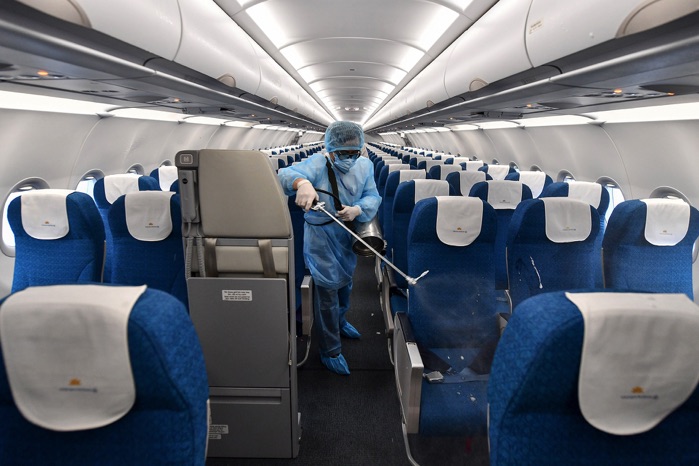It’s a challenging time for any airline to launch flights to the United States and survive in this tough aviation market. A key requirement is meeting the U.S.’s stringent safety standards. Heritage spoke with Mr. Au Duy Linh, Head of Vietnam Airlines’ Safety and Quality Standards Department and a member of the SkyTeam Air Alliance Safety Committee.

VNA is planning to launch a route to the U.S. Can you share any insights on the timeline?
Launching regular flights between Vietnam and the U.S. requires us to meet many strict standards, follow complicated legal procedures, and obtain approvals from many relevant authorities. As of January 8th, 2021, Vietnam Airlines had completed all of the required procedures. Now, we are only waiting for the license from the US Transportation Security Administration (TSA), which we expect by the end of March 2021. However, the route’s launch date will depend on a number of factors, such as developments in the Covid-19 pandemic and market conditions.
Is it true that to fly to the U.S. an airline only needs a license from the U.S. Department of Transportation and a Certificate 1 (CAT 1) rating for aviation safety from the US Federal Aviation Administration (FAA)?
A license from the U.S. Department of Transportation and a CAT1 rating from the FAA are just the first steps. To open a route to the U.S., an airline must meet many other standards and must be certified to comply with FAA-mandated operating safety regulations with an emphasis on services for people with disabilities; the TSA’s Aviation Security Regulations; regulations of U.S. Customs and Border Protection (CBP); regulations of the US National Traffic Safety Board (NTSB); and several other certifications. Vietnam Airlines has received all required certifications and is only waiting for TSA licensing.

What is the most important standard for operating flights to the U.S.?
Safety is obviously key. The route between Vietnam and the U.S. is among the most technically challenging in the world in terms of airworthiness, aircraft maintenance, ground operations, and personnel training. To meet these standards, we must make long-term and proper investments and preparations. It’s not just about having big jets and getting it done!
Which local airlines are currently qualified to operate this route?
To operate regular flights to the U.S., an airline must fully meet all U.S. standards. In terms of technical capacity and operational capacity alone, any airline operating flights to the United States must meet a threshold EDTO (Extended diversion time operation) of 180 minutes. This means the plane can fly for 180 minutes on one engine should the other one become inoperable. After taking possession of aircraft capable of long-haul flights, it usually takes a new operator 12 months to build up the required EDTO experience. In Vietnam, VNA is the only carrier to meet this standard.
In fact, VNA has been operating many special flights to serve the Party and State leaders, repatriate citizens, and transport experts between Vietnam and the United States. These flights must comply with all of the highest requirements mandated by U.S. authorities. VNA is also the only Vietnamese carrier to participate in the SkyTeam Alliance’s global emergency coordination program, of which the US’s Delta Airlines is also a member. VNA has received Air Operator Certificates (AOC) to North America (NAM), North Atlantic (NAT), and Asia-Pacific (PAC); and the FAR-145 aircraft maintenance certificate from the FAA. We also own a flight simulator (SIM) to train pilots on intercontinental and trans-ocean flights. Furthermore, VNA operates a dedicated website and special services for people with disabilities to make sure we meet the US’s highest operational requirements.

Being qualified doesn’t mean we can stop improving, right? What standards is VNA focused on perfecting?
That’s correct. We must further improve our capacity. Safety is VNA’s focus and key mission, which we achieve by maintaining strict and serious compliance with the industry standards; meeting requirements set out by aviation authorities; and regular training. Our focus on safety is shown through the motto: “The safety and health of passengers and staff is our top priority”. Safety is a constant core value in all of VNA’s activities.
How will VNA raise these standards?
In addition to strictly complying with and meeting the highest global safety standards, VNA pays special attention to safety management and promoting a culture of safety and integrity. We hold people accountable, from the top leadership to every individual team member. After all, people are the decisive factor and a safety culture must be supported by the devotion and commitment of individual employees. Our 2020 safety culture survey showed that VNA’s safety culture has steadily reached an “Active 4.0” (Proactive) level. We are striving to achieve the ultimate goal of an “Advanced 5.0” (Generative) level in the near future.
Operating flights to the United States is extremely challenging and costly. Why is VNA determined to move forward with this?
It is very challenging and costly because of the long distance and due to fierce market competition. Several American airlines operating this route had to give up even before the Covid-19 pandemic.
However, launching this flight route not only facilitates travel for over two million Vietnamese-Americans (Viet Kieu) living in the United States, and contributes to the development of investment, trade, and tourism between the two countries, but also creates an opportunity for VNA to improve and differentiate our service quality and capacity to ensure safe operations that meet the world’s highest standards.










